Numerical Simulation of Snowdrift Development in Non-Equilibrium Flow Fields Around Buildings
Abstract
:1. Introduction
2. Numerical Model
2.1. Governing Equations
2.2. Two Transport Equations for Snow Mass Concentration
2.3. Conservative Snowdrift Model
2.4. Time-Marching Method
2.5. Mesh-Morphing Method
3. Results and Discussion
3.1. Cubic Building
3.1.1. Overview of the Cubic Building Problem
3.1.2. Comparison of Observation and Analysis Results of the Cubic Building Problem
3.2. Porous Fence
3.2.1. Overview of the Porous Fence Problem
3.2.2. Comparison of Observation and Analysis Results of the Porous Fence Problem
3.3. Two-Level Flat Roof
3.3.1. Overview of the Two-Level Flat Room Problem
3.3.2. Comparison of Observation and Analysis Results of the Two-Level Flat Room Problem
4. Conclusions
- In this study, we conducted a numerical simulation of snowdrifts considering the fetch distance of the saltation layer to predict drifting snow phenomena around buildings. We performed a snowdrift analysis to quantitatively compare the simulation results with actual measurements of snow depth near the buildings;
- In the case of studying drifting snow phenomena around cubic buildings, it was observed that without the development of a saltation layer under the average wind velocity, the snowdrifts in front of the cube were not reproduced accurately in the simulation. However, when considering the conditions for the development of a saltation layer, the snowdrifts were successfully reproduced, leading to relatively good agreement between the simulation results and actual measurements;
- In the snow porous fence, the measured snow profile matches previous studies up to the snowdrift peak position but underestimates the snow depth beyond that point. The snow depth initially decreases gently from the peak position and then increases over time. The saltation transport rate can change the snow depth distribution at the blowdown location. Therefore, the value of the saltation transport rate can vary greatly depending on the value of the saltation fetch distance, but more detailed data such as the degree of saltation development are considered necessary to determine its value;
- In the case of studying drifting snow phenomena around a two-level flat roof, the snow particles lifted by the erosion of the snow surface at the lower end of the stepped roof during the initial calculations contributed to the formation of snowdrifts downstream. As the snowdrifts formed, flow separation vortices developed downstream, which further accelerated the erosion. Overall, the distribution of snow depth showed relatively good qualitative and quantitative agreement between the simulation and actual measurements.
Author Contributions
Funding
Data Availability Statement
Conflicts of Interest
References
- Mitsuhashi, H. Snowdrifting on building and wind tunnel experiment using model snow. J. Jpn. Soc. Snow Ice 2003, 65, 287–295. [Google Scholar]
- Shuji, S.; Osamu, A.B.E.; Osamu, J.O.H. Wind Tunnel on effect of roof wind pressure of buildings on shaping roof snow accumulations. J. Struct. Constr. Eng. 2009, 74, 451–458. [Google Scholar]
- Oikawa, S.; Tomabechi, T.; Ishihara, T. Study of wind tunnel similarity on snowdrift around buildings. Nagare 2007, 26, 319–324. [Google Scholar]
- Uematsu, T.; Nakata, T.; Takeuchi, K.; Arisawa, Y.; Kaneda, Y. Three-dimensional numerical simulation of snowdrift. Cold Reg. Sci. Technol. 1991, 20, 65–73. [Google Scholar]
- Iversen, J.D.; Greeley, R.; White, B.R.; Pollack, J.B. Eolian erosion of the Martian surface, part 1: Erosion rate similitude. Icarus 1980, 26, 321–331. [Google Scholar]
- Pomeroy, J.W.; Gray, D.M. Saltation of snow. Water Resour. Res. 1990, 26, 1583–1594. [Google Scholar]
- Okaze, T.; Mochida, A.; Yoshino, H.; Tominaga, Y.; Nemoto, M.; Sato, T.; Ito, Y. Modeling of snowdrift in non-equilibrium flowfields around buildings—(Part2) Universal relation between the streamwise distance and the transport rate of drifting snow. In Summaries of JSSI and JSSE Joint Conference on Snow and Ice Research; The Japanese Society of Snow and Ice/Japan Society for Snow Engineering: Tokyo, Japan, 2008; Volume 2008, p. 217. [Google Scholar]
- Liston, G.E.; Sturm, M. A snow-transport model for complex terrain. J. Glaciol. 1998, 44, 498–516. [Google Scholar]
- ANSYS Fluent; 2022R2; ANSYS Fluent Theory Guide; ANSYS Inc.: Canonsburg, PA, USA, 2022.
- Beyers, M.; Waechter, B. Modeling transient snowdrift development around complex three-dimensional structures. J. Wind Eng. Ind. Aerodyn. 2008, 96, 1603–1615. [Google Scholar]
- Thiis, T.; Ferreira, A.D. Sheltering effect and snow deposition in arrays of vertical pillars. Environ. Fluid Mech. 2015, 15, 27–39. [Google Scholar]
- Zhou, X.; Kang, L.; Gu, M.; Qiu, L.; Hu, J. Numerical simulation and wind tunnel test for redistribution of snow on a flat roof. J. Wind Eng. Ind. Aerodyn. 2016, 153, 92–105. [Google Scholar]
- Franke, R. Scattered data interpolation: Tests of some methods. Math. Comput. 1982, 38, 181–200. [Google Scholar]
- Zhu, F.; Yu, Z.; Zhao, L.; Xue, M.; Zhao, S. Adaptive-mesh method using RBF interpolation: A time-marching analysis of steady snow drifting on stepped flat roofs. J. Wind Eng. Ind. Aerodyn. 2017, 171, 1–11. [Google Scholar] [CrossRef]
- Groth, C.; Costa, E.; Biancolini, M.E. RBF-based mesh morphing approach to perform icing simulations in the aviation sector. Aircr. Eng. Aerosp. Technol. 2019, 91, 620–633. [Google Scholar] [CrossRef]
- Mochida, A.; Yoshino, H.; Okaze, T.; Tominaga, Y.; Lto, Y. Modeling of snowdrift in non-equilibrium flowfields around buildings—(Part 3) New snowdrift model incorporating the effects of drifting snow particles on turbulent flow. In Summaries of JSSI and JSSE Joint Conference on Snow and Ice Research; The Japanese Society of Snow and Ice/Japan Society for Snow Engineering: Tokyo, Japan, 2008; Volume 2008, p. 218. [Google Scholar]
- Lto, Y.; Tominage, Y.; Okaze, T.; Mochida, A.; Nemoto, M. Modeling of snowdrift in non-equilibrium flowfields around buildings–(Part1) Wind tunnel measurements of spatial distribution of mass flux of drifting snow in developing snow boundary layer. In Summaries of JSSI and JSSE Joint Conference on Snow and Ice Research; The Japanese Society of Snow and Ice/Japan Society for Snow Engineering: Tokyo, Japan, 2008; Volume 2008, p. 216. [Google Scholar]
- Naaim, M.; Naaim-Bouvet, F.; Martinez, H. Numerical simulation of drifting snow: Erosion and deposition models. Ann. Glaciol. 1998, 26, 191–196. [Google Scholar] [CrossRef]
- Launder, B.E.; Spalding, D.B. The numerical computation of turbulent flows. Comput. Methods Appl. Mech. Eng. 1974, 3, 269–289. [Google Scholar] [CrossRef]
- Okaze, T.; Tominaga, Y.; Mochida, A. Development of new snowdrift model based on two transport equations of drifting snow density: Numerical prediction of snowdrift around buildings using CFD (Part 2). J. Environ. Eng. 2013, 78, 149–156. [Google Scholar] [CrossRef]
- Sato, T.; Mochizuki, S.; Kosugi, K.; Nemoto, M. Effects of particle shape on mass flux measurement of drifting snow by snow particle counter. J. Jpn. Soc. Snow Ice 2005, 67, 493–503. [Google Scholar] [CrossRef]
- Moore, I. Numerical Modeling of Blowing Snow Around Buildings. Ph.D. Thesis, Department of Applied Mathematical Studies, University of Leeds, Leeds, UK, 1995. [Google Scholar]
- Beyers, J.H.M. Numerical Modeling of the Snow Flow Characteristics Surrounding SANAE IV Research Station, Antarctica. Ph.D. Thesis, Department of Mechanical Engineering, University of Stellenbosch, Stellenbosch, South Africa, 2004. [Google Scholar]
- Nemoto, M.; Nishimura, K.; Kobayashi, S.; Izumi, K. Numerical study of the time development of drifting snow and its relation to the spatial development. Ann. Glaciol. 2004, 38, 343–350. [Google Scholar] [CrossRef]
- Xu, Y.; Xu, Y.; Mustafa, M.Y.; Mustafa, M.Y.; Solvang, W.D.; Solvang, W.D. CFD aided cognitive capabilities for analyzing snowdrift development around a porous fence. In Proceedings of the 2014 5th IEEE Conference on Cognitive Infocommunications (CogInfoCom), Vietri sul Mare, Italy, 5–7 November 2014. [Google Scholar]
- Shao, Y.; Li, A. Numerical modeling of saltation in the atmospheric surface layer. Bound.-Layer Meteorol. 1999, 91, 199–225. [Google Scholar] [CrossRef]
- Buhmann, M.D. Radial basis functions. Acta Numer. 2000, 9, 1–38. [Google Scholar] [CrossRef]
- de Boer, A.; van der Schoot, M.S.; Bijl, H. Mesh deformation based on radial basis function interpolation. Comput. Struct. 2007, 85, 784–795. [Google Scholar] [CrossRef]
- Beckert, A.; Wendland, H. Multivariate interpolation for fluid-structure-interaction problems using radial basis functions. Aerosp. Sci. Technol. 2001, 2, 125–134. [Google Scholar] [CrossRef]
- Biancolini, M.E. Fast Radial Basis Functions for Engineering Applications; Springer: Berlin/Heidelberg, Germany, 2018. [Google Scholar]
- Chiappa, A.; Groth, C.; Biancolini, M.E. A two-scale RBF meshless method for the interface stress retrieval in simply bended and torqued long-fibres laminates. Compos. Struct. 2023, 306, 116600. [Google Scholar] [CrossRef]
- Oikawa, S.; Tomabechi, T.; Ishihara, T. One-day observations of snowdrifts around a model cube. J. Snow Eng. Jpn. 1999, 15, 3–11. [Google Scholar] [CrossRef]
- Bagnold, R.A. The Physics of Blown Sand and Desert Dunes; Methuen and Co.: London, UK, 1941. [Google Scholar]
- Clifton, A.; Rüedi, J.-D.; Lehning, M. Snow saltation threshold measurements in a drifting-snow wind tunnel. J. Glaciol. 2006, 52, 585–596. [Google Scholar] [CrossRef]
- Tabler, R.D. Geometry and density of drift formed by snow fences. J. Glaciol. 1980, 26, 405–419. [Google Scholar] [CrossRef]
- Iversen, J.D. Comparison of wind tunnel model and full scale snow fence drifts. J. Wind Eng. Ind. Aerodyn. 1981, 8, 231–249. [Google Scholar] [CrossRef]
- Pomeroy, J.W. A process-based model of snow drifting. Ann. Glaciol. 1989, 13, 237–240. [Google Scholar] [CrossRef]
- Greeley, R.; Iversen, J.D. Wind as a Geological Process on Earth, Mars, Venus and Titan; Cambridge University Press: Cambridge, UK, 1985. [Google Scholar]
- Tsuchiya, M.; Tomabechi, T.; Hongo, T.; Ueda, H. Characteristics of wind flow acting on snowdrift on a stepped flat roof. J. Struct. Constr. Eng. AIJ 2002, 67, 53–59. [Google Scholar] [CrossRef]

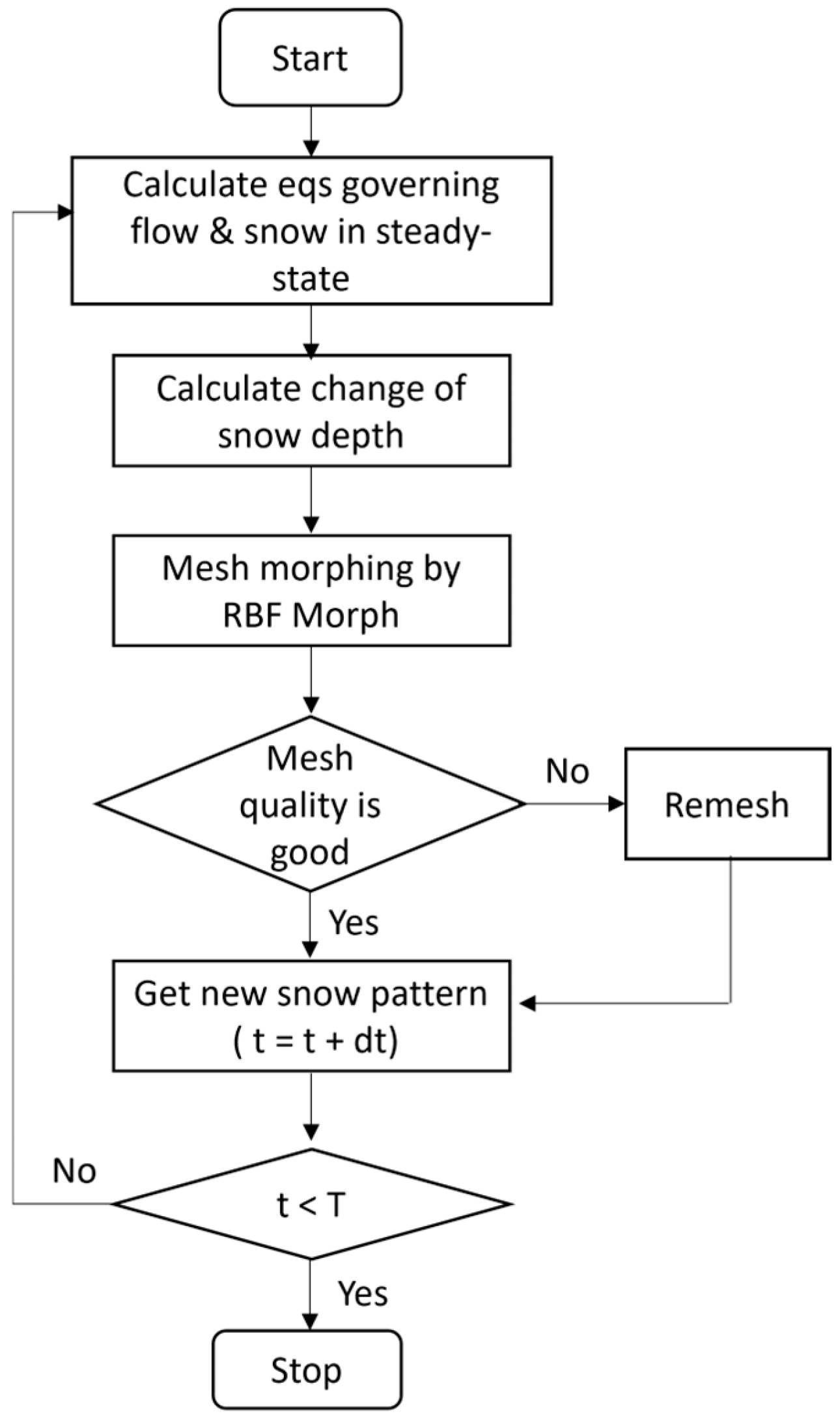



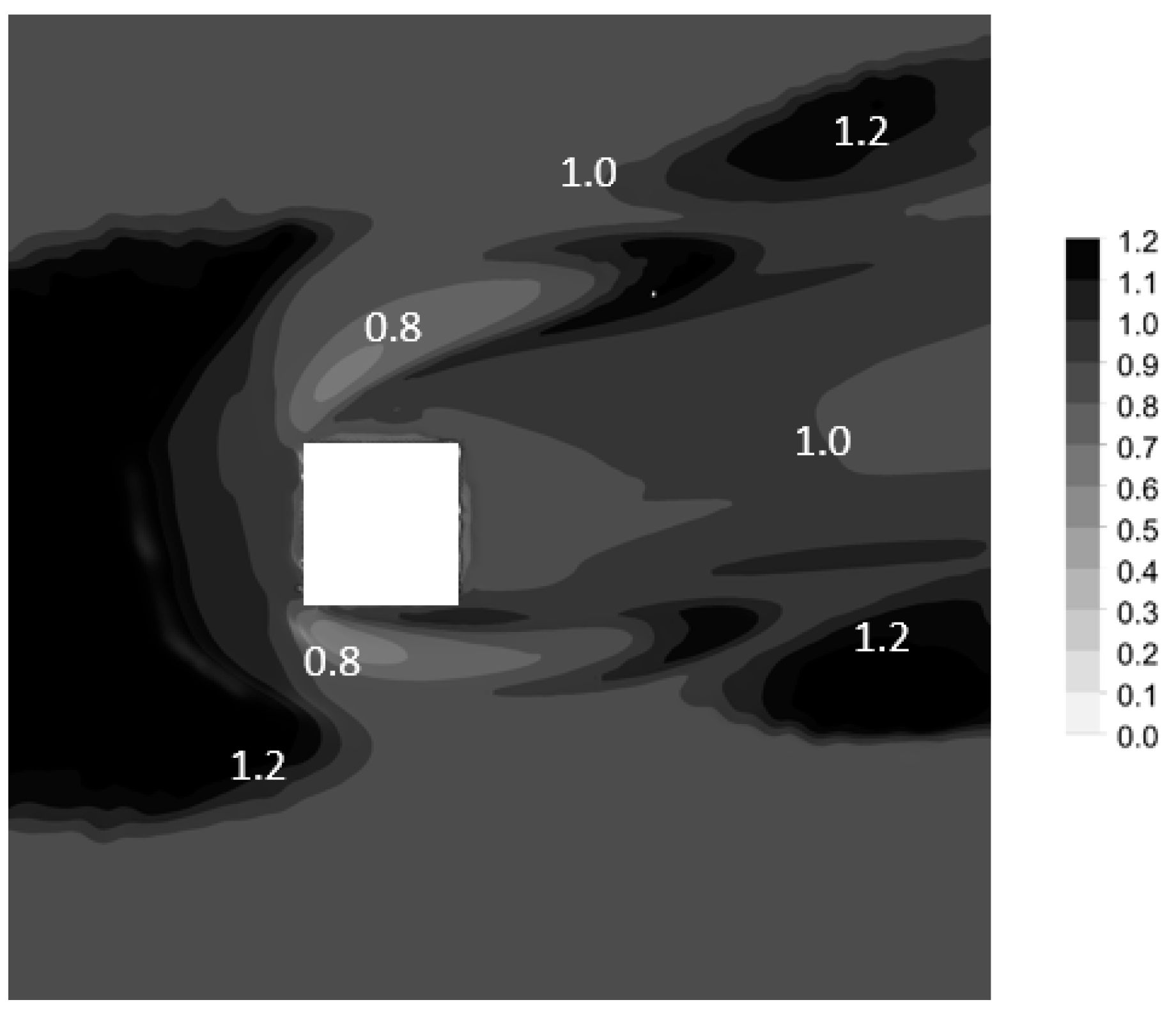

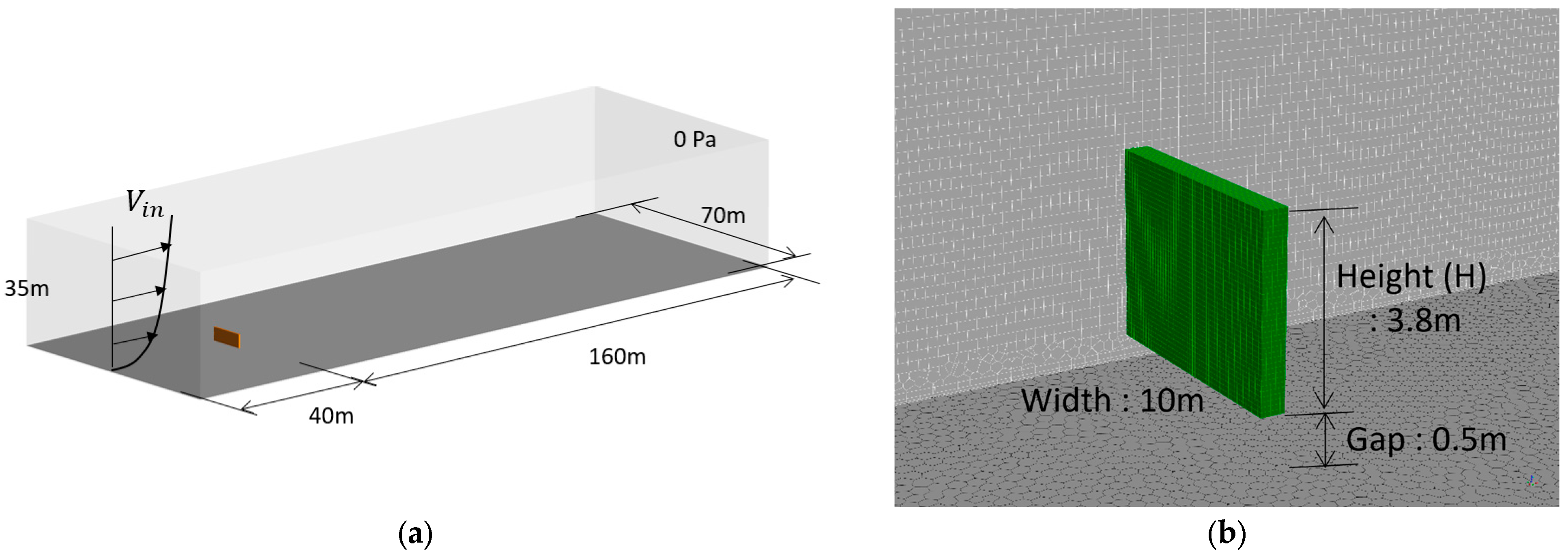
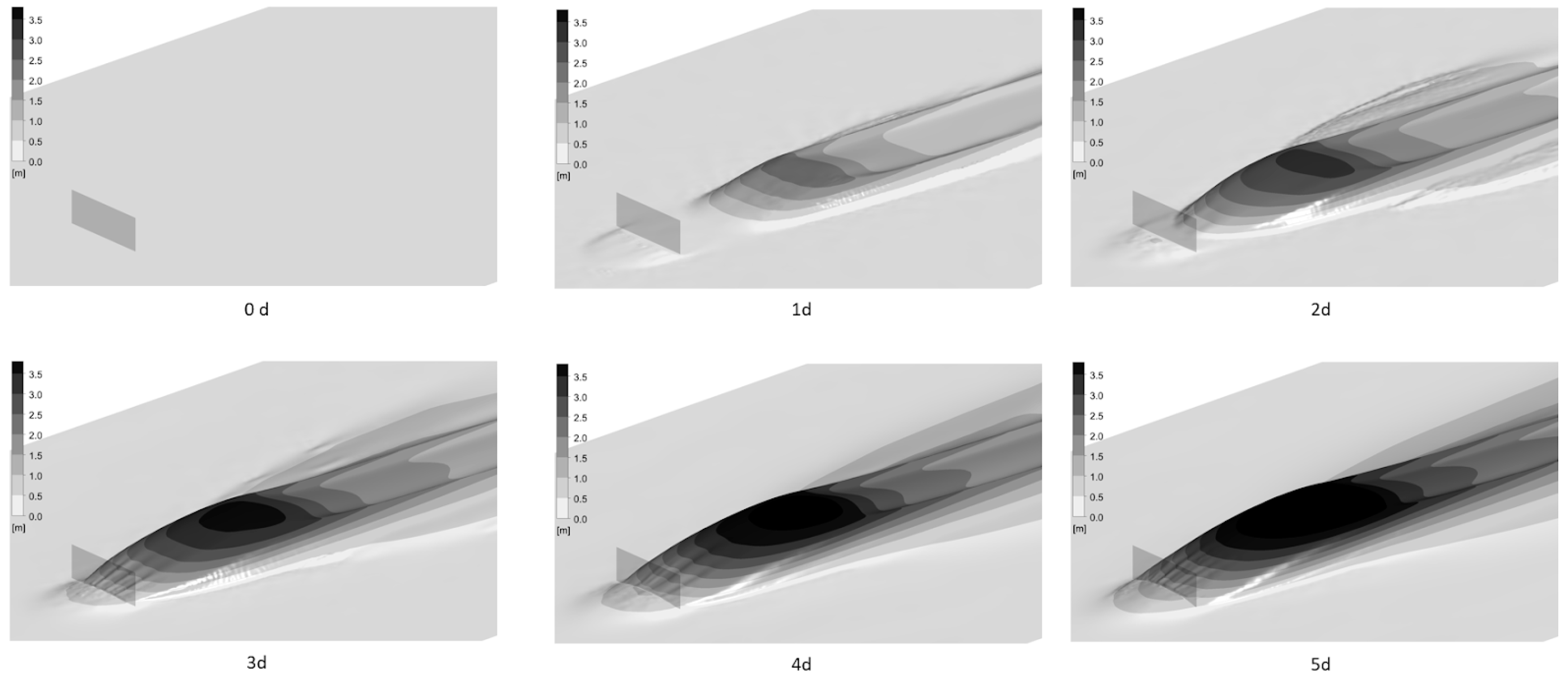
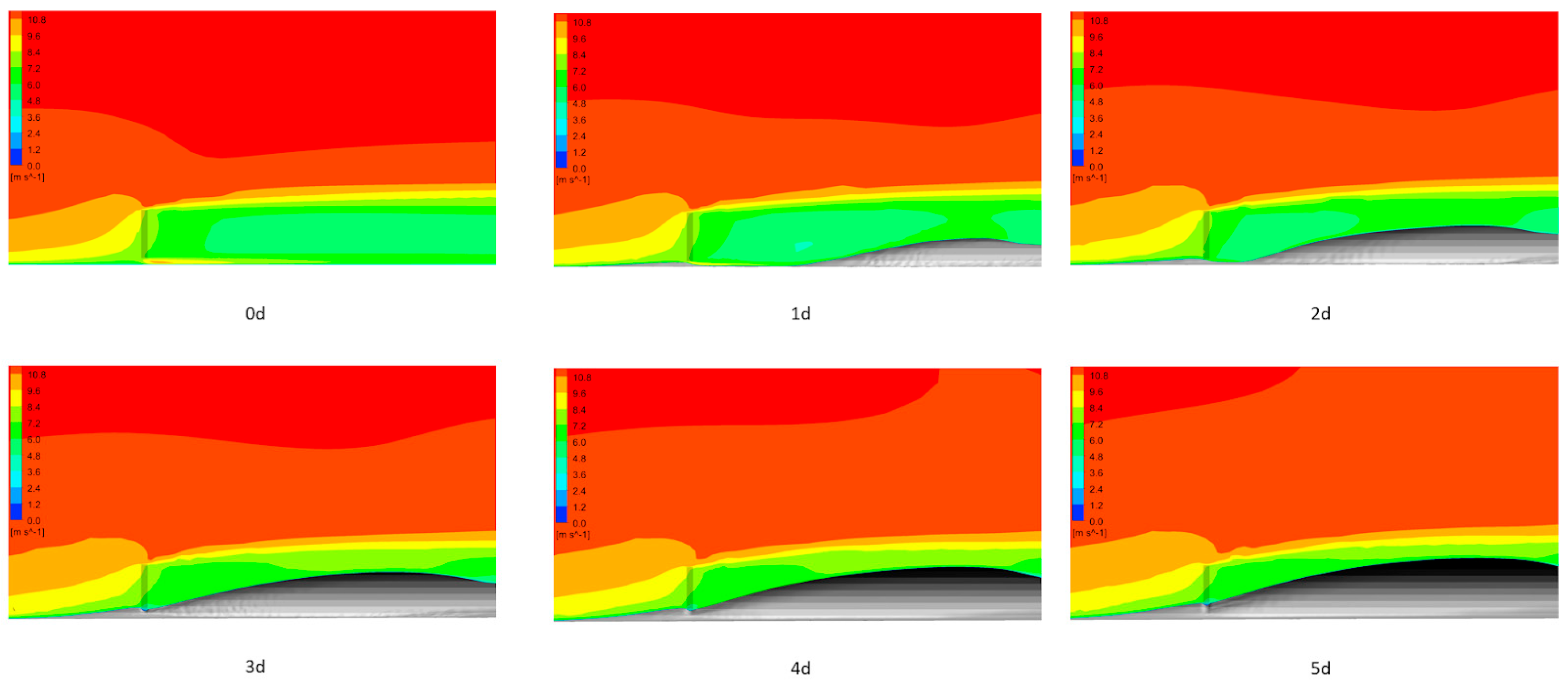

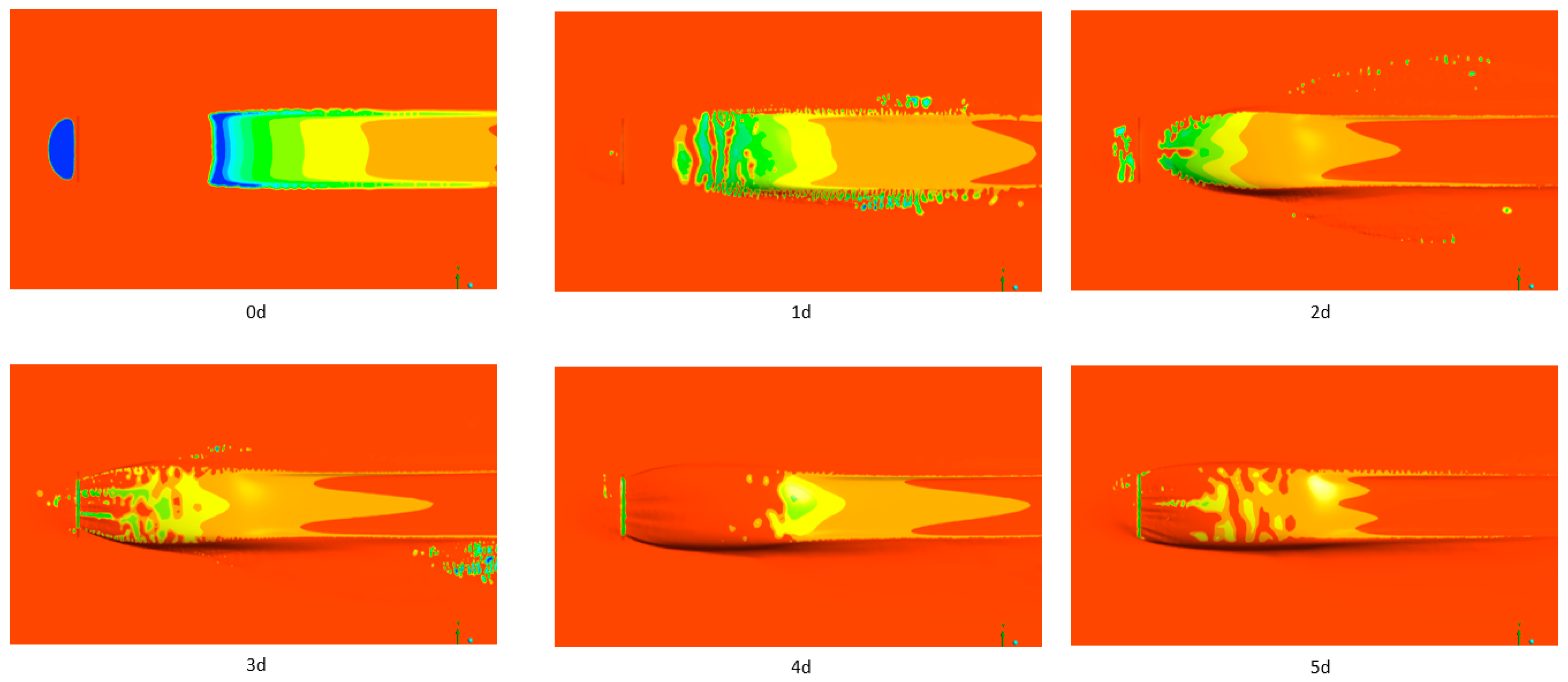

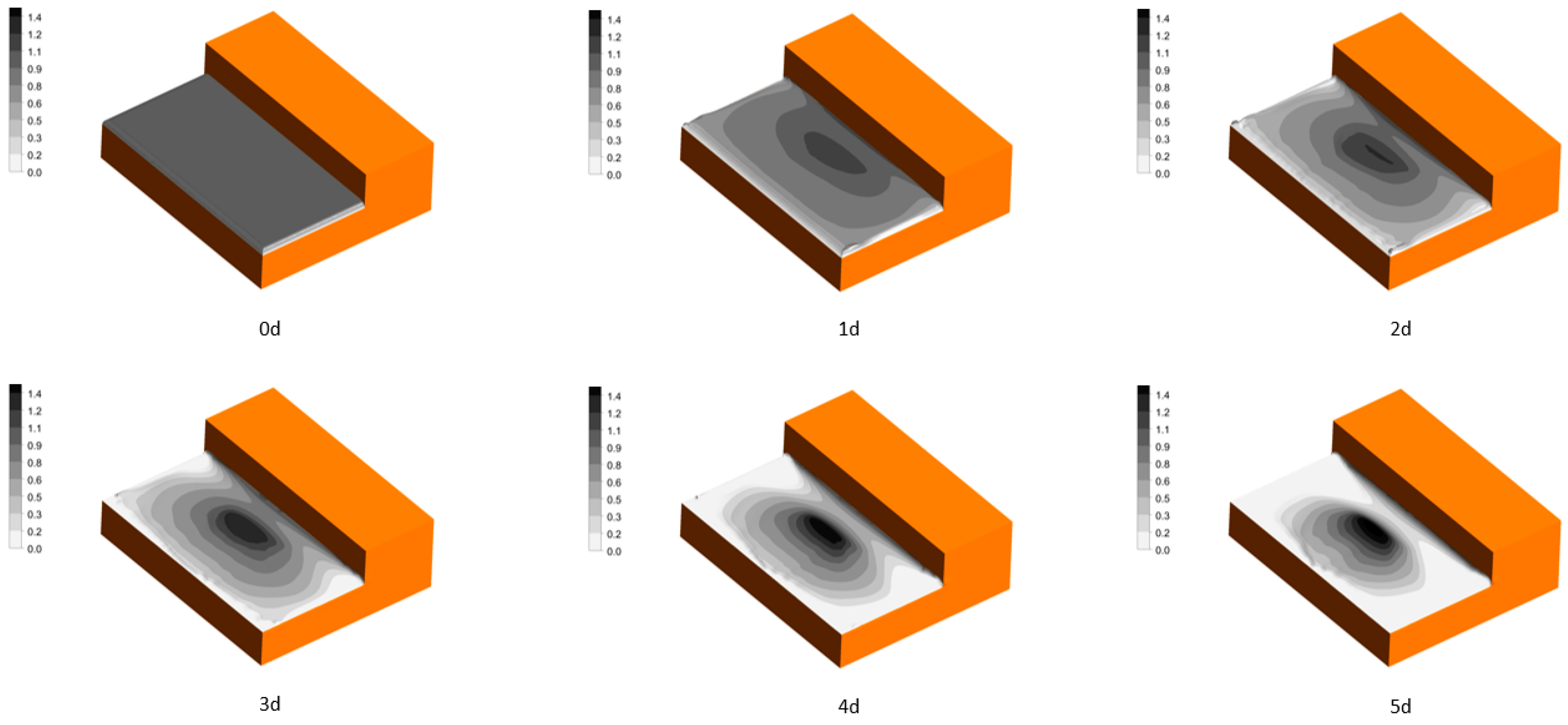
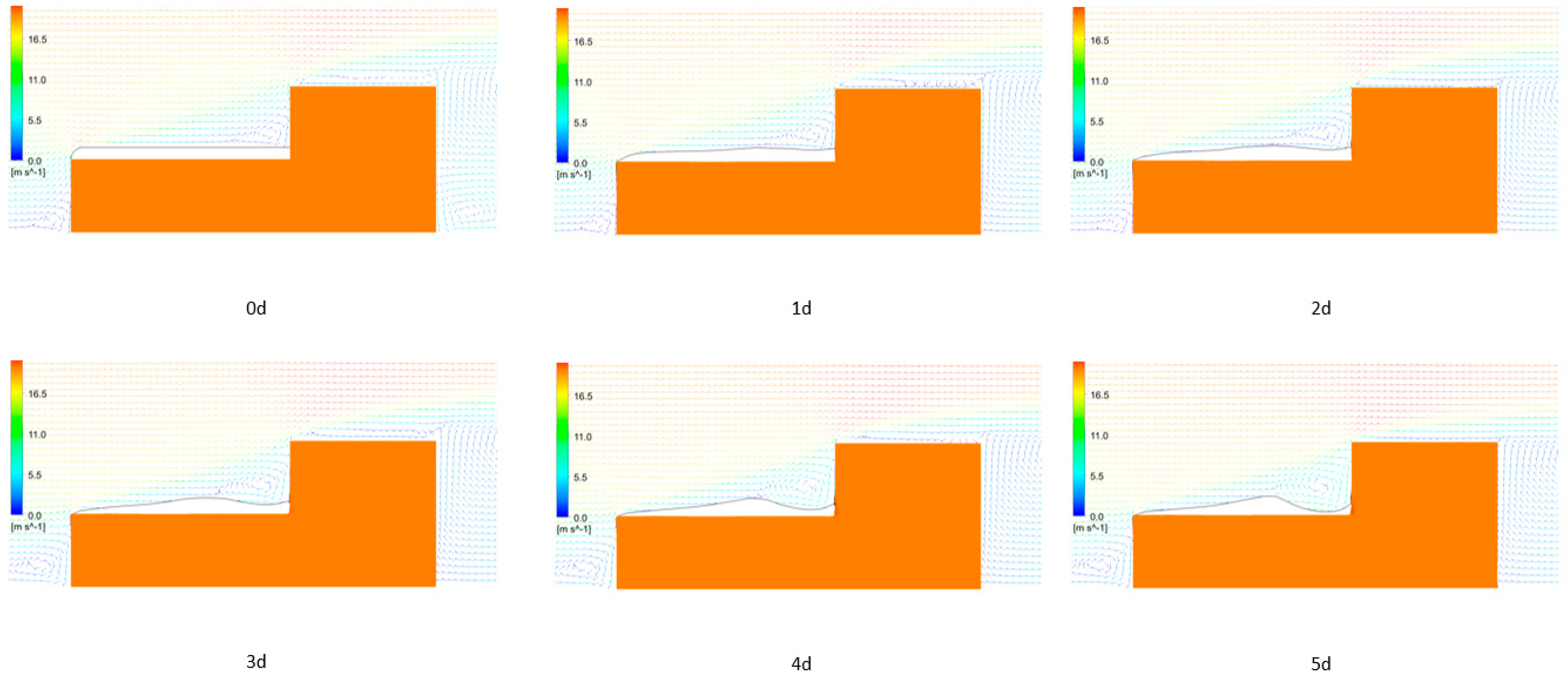


| Threshold friction velocity | 0.164 (m/s) |
| Aerodynamic roughness height | 1.0 × 10−4 (m) |
| Density of snow particle | 100.0 (kg/m3) |
| Diameter of snow particle | 1.0 × 10−4 (m) |
| Falling velocity of snow particle | 1.0 (m/s) |
| Falling velocity of snow particle | 0.3 (m/s) |
| Inlet | (m/s) Average wind direction is a 10-degree rotation from the normal direction to the front of the cubic building |
| Snow mass concentration (kg/m3) | |
| Snow mass concentration (kg/m3) | |
| Inlet fetch distance (m) | |
| Reynolds number 2.93 × 105 | |
| Side | Symmetry |
| Top | Slip wall |
| Zero gradient in normal direction | |
| Outlet | 0 (Pa) |
| Zero gradient in normal direction | |
| Building, ground | No slip wall, standard wall function |
| Turbulence model | Realizable |
| Advection scheme | Momentum: QUICK |
| Others: Second-Order Upwind | |
| Time-marching step size | 30 (min) |
| Threshold friction velocity | 0.28 (m/s) |
| Aerodynamic roughness height | 1.0 × 10−4 (m) |
| Density of snow particle | 150.0 (kg/m3) |
| Diameter of snow particle | 1.1 × 10−4 (m) |
| Falling velocity of snow particle | 0.45 (m/s) |
| Falling velocity of snow particle | 0.3 (m/s) |
| Inlet | |
| Snow mass concentration (kg/m3) | |
| Snow mass concentration (kg/m3) | |
| Inlet fetch distance (m) | |
| Reynolds number 2.85 × 106 | |
| Side | Symmetry |
| Top | Slip wall |
| Zero gradient in normal direction | |
| Outlet | 0 (Pa) |
| Zero gradient in normal direction | |
| Building, ground | No slip wall, standard wall function |
| Turbulence model | Realizable |
| Advection scheme | Momentum: QUICK |
| Others: Second-Order Upwind | |
| Time-marching step size | 30 (min) |
| Threshold friction velocity | 0.20 (m/s) |
| Aerodynamic roughness height | 2.0 × 10−3 (m) |
| Density of snow particle | 250.0 (kg/m3) |
| Diameter of snow particle | 1.1 × 10−4 (m) |
| Falling velocity of snow particle | 0.20 (m/s) |
| Falling velocity of snow particle | 0.20 (m/s) |
| Inlet | is the Karman constant |
| Snow mass concentration (kg/m3) | |
| Snow mass concentration (kg/m3) | |
| Inlet fetch distance (m) | |
| Reynolds number 2.25 × 106 | |
| Side | Symmetry |
| Top | Slip wall |
| Zero gradient in normal direction | |
| Outlet | 0 (Pa) |
| Zero gradient in normal direction | |
| Building, ground | No slip wall, standard wall function |
| Turbulence model | Realizable |
| Advection scheme | Momentum: QUICK |
| Others: Second-Order Upwind | |
| Time-marching step size | 120 (min) |
Disclaimer/Publisher’s Note: The statements, opinions and data contained in all publications are solely those of the individual author(s) and contributor(s) and not of MDPI and/or the editor(s). MDPI and/or the editor(s) disclaim responsibility for any injury to people or property resulting from any ideas, methods, instructions or products referred to in the content. |
© 2025 by the authors. Licensee MDPI, Basel, Switzerland. This article is an open access article distributed under the terms and conditions of the Creative Commons Attribution (CC BY) license (https://creativecommons.org/licenses/by/4.0/).
Share and Cite
Nara, R.; Groth, C.; Biancolini, M.E. Numerical Simulation of Snowdrift Development in Non-Equilibrium Flow Fields Around Buildings. Fluids 2025, 10, 75. https://doi.org/10.3390/fluids10040075
Nara R, Groth C, Biancolini ME. Numerical Simulation of Snowdrift Development in Non-Equilibrium Flow Fields Around Buildings. Fluids. 2025; 10(4):75. https://doi.org/10.3390/fluids10040075
Chicago/Turabian StyleNara, Ryu, Corrado Groth, and Marco Evangelos Biancolini. 2025. "Numerical Simulation of Snowdrift Development in Non-Equilibrium Flow Fields Around Buildings" Fluids 10, no. 4: 75. https://doi.org/10.3390/fluids10040075
APA StyleNara, R., Groth, C., & Biancolini, M. E. (2025). Numerical Simulation of Snowdrift Development in Non-Equilibrium Flow Fields Around Buildings. Fluids, 10(4), 75. https://doi.org/10.3390/fluids10040075






